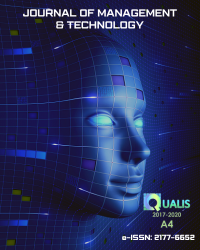Nobel Prize in Economics: retrospectove analysis and prediction of laureates
DOI:
https://doi.org/10.20397/2177-6652/2023.v23i2.2616Palabras clave:
Nobel Prize, Laureates in economics, Analysis, Prognostication, Retrospective dataResumen
The purpose of the article is to analyze retrospective data on the laureates of the Sveriges Riksbank Prize in Economic Sciences in Memory of Alfred Nobel for the years 1969-2022 and to try to predict three parameters of 2023: the number of scientists who will receive the award; the part of the world in which the place of work of the laureate(s) is located; age of laureate / average age of laureates. During the years 1969–2022, the prize was awarded 54 times, and 92 people became its laureates. 74 awardees are affiliated with North America. The age of most scientists at the time of awarding was from 61 to 70 years. According to the obtained forecast trend models, in 2023 the laureates of the prize will be 3 people, representatives of higher education institutions from North America, whose average age will be in the range of 61–70 years.Citas
Bhattacharyya, P. Kr., & Sahu, N. B. (2020). Informetric portrait of Elinor Ostrom, the Nobel laureate in the field of economic sciences. Journal of Scientometric Research, 9(2), 204–213. https://doi.org/10.5530/jscires.9.2.25.
Bjork, R. (2019). The age at which Noble Prize research is conducted. Scientometrics, 119(2), 931–939. https://doi.org/10.1007/s11192-019-03065-4.
Bjork, S., Offer, A., & Soderberg, G. (2014). Time series citation data: the Nobel Prize in economics. Scientometrics, 98(1), 185–196. https://doi.org/10.1007/s11192-013-0989-5.
Boettke, P. J., Fink, A., & Smith, D. J. (2012). The impact of Nobel Prize winners in economics: mainline vs. mainstream. American Journal of Economics and Sociology, 71(5), 1219–1249. https://doi.org/10.1111/j.1536-7150.2012.00861.x.
Chan, H. F., Mixon, F. G., Jr., & Torgler, B. (2018). Relation of early career performance and recognition to the probability of winning the Nobel Prize in economics. Scientometrics, 114(3), 1069–1086. https://doi.org/10.1007/s11192-017-2614-5.
Chan, H. F., & Torgler, B. (2012). Econometric fellows and Nobel laureates in economics. Economics Bulletin, 32(4), 3365–3377.
Charlton, B. G. (2007). Scientometric identification of elite “revolutionary science” research institutions by analysis of trends in Nobel Prizes 1947-2006. Medical Hypotheses, 68(5), 931–934. https://doi.org/10.1016/j.mehy.2006.12.006.
Claes, A. G. P., & de Ceuster, M. J. K. (2013). Estimating the economics Nobel Prize laureates’ achievement from their fame. Applied Economics Letters, 20(9), 884–888. https://doi.org/10.1080/13504851.2012.758836.
Cortes, J. D., & Andrade, D. A. (2022). The Colombian scientific elite-Science mapping and a comparison with Nobel Prize laureates using a composite citation indicator. PLoS ONE, 17(5). https://doi.org/10.1371/journal.pone.0269116.
Einav, L., & Leeat Y. (2006). What’s in a surname? The effects of surname initials on academic success. Journal of Economic Perspectives, 20(1), 175–187. https://doi.org/10.1257/089533006776526085.
Garfield, E. (1990). Who will win the Nobel-Prize in economics – heres a forecast based on citation indicators. Current Contents, 11, 3–7.
Huston, J. H., & Spencer, R. W. (2018). Using network centrality to inform our view of Nobel economists. Eastern Economic Journal, 44(4), 616–628. https://doi.org/10.1057/s41302-018-0111-z.
Korom, P. (2022). Are there institutionalized pathways to the Nobel Prize in economics? In book: The power and influence of economists: contributions to the social studies of economics (pp. 209–226). Routledge, Oxford.
Mitsis, P. (2022). The Nobel Prize time gap. Humanities & Social Sciences Communications, 9(1). https://doi.org/10.1057/s41599-022-01418-8.
Mixon, F. G., Jr., Torgler, B., & Upadhyaya, K. P. (2017). Scholarly impact and the timing of major awards in economics. Scientometrics, 112(3), 1837–1852. https://doi.org/10.1007/s11192-017-2429-4.
Molina, J. A., Iniguez, D., Ruiz, G., & Tarancon, A. (2021). Leaders among the leaders in economics: a network analysis of the Nobel Prize laureates. Applied Economics Letters, 28(7), 584–589. https://doi.org/10.1080/13504851.2020.1764478.
Nelson, M. (2005). Academic home pages and Nobel laureates. In ISSI 2005: Proceedings of the 10th International Conference of the International Society for Scientometrics and Informetrics, 1 and 2, 2005, (pp. 193–196).
Nobel Prize Outreach (2022a). About the prize. Available at: https://www.nobelprize.org/prizes/economic-sciences/.
Nobel Prize Outreach (2022b). All prizes in economic sciences. Available at: https://www.nobelprize.org/prizes/lists/all-prizes-in-economic-sciences/.
Petrík, B. (2004). Anniversary of the Nobel Prize in economy | [Nobelova cena za ekonómiu jubiluje]. Ekonomicky casopis, 52(10), 1275–1290.
Prinz, A. (2017). Memorability of Nobel Prize laureates in economics. Applied Economics Letters, 24(6), 433–437. https://doi.org/10.1080/13504851.2016.1200176.
Sanderson, A. R., & Siegfried, J. J. (2019). The Nobel Prize in economics turns 50. American Economist, 64(2), 167–182. https://doi.org/10.1177/0569434519852429.
Shanahan, M. P., Wilson, J. K., & Becker, W. E. (2012). Following Zahka: using Nobel Prize winners’ speeches and ideas to teach economics. Journal of Economic Education, 43(2), 190–199. https://doi.org/10.1080/00220485.2012.660055.
Sirůček, P. (2021). Quo vadis, Nobel Prize in economic sciences? | [QUO vadis, „nobelovskÉ“ocenānÍ za ekonomickÉ vādy?]. Politicka Ekonomie, 69(4), 497–504. https://doi.org/10.18267/J.POLEK.1321.
Tol, R. S. J. (2022). Rise of the Kniesians: the professor-student network of Nobel laureates in economics. European Journal of the History of Economic Thought, 29(4), 680–703. https://doi.org/10.1080/09672567.2022.2074494.
Torgler, B., Antić, N., & Dulleck, U. (2008). Mirror, mirror on the wall, who is the happiest of them all? Kyklos, 61(2), 309–319. https://doi.org/10.1111/j.1467-6435.2008.00403.x.
Author. (2004).
Walter, C. E., Ferasso, M., Veloso, C. M., & Auyong-Oliveira, M. (2022). The creation and dissemination of scientific knowledge: an empirical analysis of economic Nobel Prizes and open innovation scientific performance. Quality-Access to Success, 23(187), 232–243. https://doi.org/10.47750/QAS/23.187.29.
Wu, J., Lozano, S., & Helbing, D. (2011). Empirical study of the growth dynamics in real career h-index sequences. Journal of Informetrics, 5(4), 489–497. https://doi.org/10.1016/j.joi.2011.02.003.
Zhang, H. H., Zuccala, A. A., & Ye, F.Y. (2019). Tracing the “swangroups” of physics and economics in the key publications of Nobel laureates. Scientometrics, 119(1), 425–436. https://doi.org/10.1007/s11192-019-03036-9.
Descargas
Publicado
Cómo citar
Número
Sección
Licencia
Derechos de autor 2023 Journal of Management & Technology

Esta obra está bajo una licencia internacional Creative Commons Atribución-NoComercial 4.0.
Os direitos, inclusive os de tradução, são reservados. É permitido citar parte de artigos sem autorização prévia desde que seja identificada a fonte. A reprodução total de artigos é proibida. Em caso de dúvidas, consulte o Editor.


